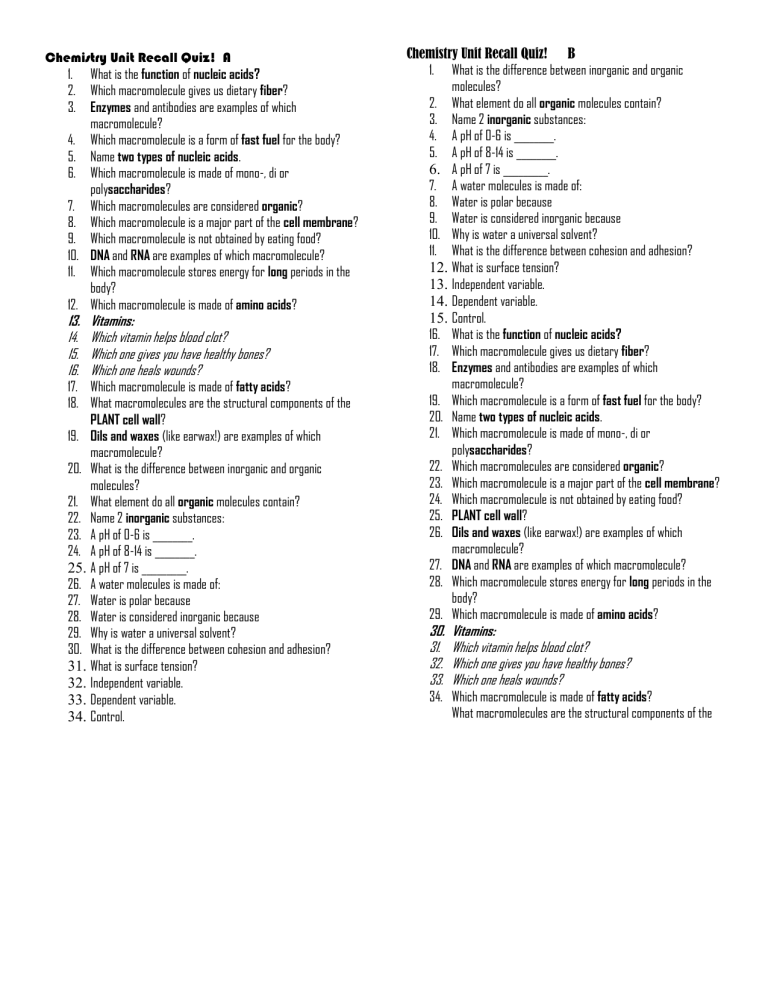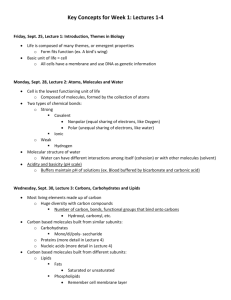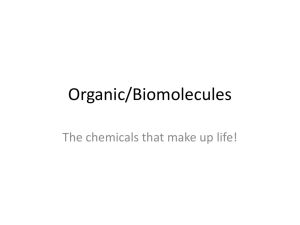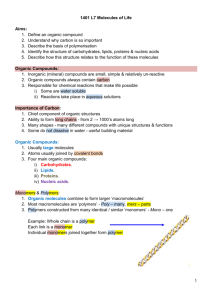13.3-BIO-CHEM-QUIZ-recall-rw.chemistryunit.strips

Chemistry Unit Recall Quiz! A
1.
What is the function of nucleic acids?
2.
Which macromolecule gives us dietary fiber ?
3.
Enzymes and antibodies are examples of which macromolecule?
4.
Which macromolecule is a form of fast fuel for the body?
5.
Name two types of nucleic acids .
6.
Which macromolecule is made of mono-, di or poly saccharides ?
7.
Which macromolecules are considered organic ?
8.
Which macromolecule is a major part of the cell membrane ?
9.
Which macromolecule is not obtained by eating food?
10.
DNA and RNA are examples of which macromolecule?
11.
Which macromolecule stores energy for long periods in the body?
12.
Which macromolecule is made of amino acids ?
13.
Vitamins:
14.
Which vitamin helps blood clot?
15.
Which one gives you have healthy bones?
16.
Which one heals wounds?
17.
Which macromolecule is made of fatty acids ?
18.
What macromolecules are the structural components of the
PLANT cell wall ?
19.
Oils and waxes (like earwax!) are examples of which macromolecule?
20.
What is the difference between inorganic and organic molecules?
21.
What element do all organic molecules contain?
22.
Name 2 inorganic substances:
23.
A pH of 0-6 is ________.
24.
A pH of 8-14 is ________.
25.
A pH of 7 is _________.
26.
A water molecules is made of:
27.
Water is polar because
28.
Water is considered inorganic because
29.
Why is water a universal solvent?
30.
What is the difference between cohesion and adhesion?
31.
What is surface tension?
32.
Independent variable.
33.
Dependent variable.
34.
Control.
Chemistry Unit Recall Quiz! B
1.
What is the difference between inorganic and organic molecules?
2.
What element do all organic molecules contain?
3.
Name 2 inorganic substances:
4.
A pH of 0-6 is ________.
5.
A pH of 8-14 is ________.
6.
A pH of 7 is _________.
7.
A water molecules is made of:
8.
Water is polar because
9.
Water is considered inorganic because
10.
Why is water a universal solvent?
11.
What is the difference between cohesion and adhesion?
12.
What is surface tension?
13.
Independent variable.
14.
Dependent variable.
15.
Control.
16.
What is the function of nucleic acids?
17.
Which macromolecule gives us dietary fiber ?
18.
Enzymes and antibodies are examples of which macromolecule?
19.
Which macromolecule is a form of fast fuel for the body?
20.
Name two types of nucleic acids .
21.
Which macromolecule is made of mono-, di or poly saccharides ?
22.
Which macromolecules are considered organic ?
23.
Which macromolecule is a major part of the cell membrane ?
24.
Which macromolecule is not obtained by eating food?
25.
PLANT cell wall ?
26.
Oils and waxes (like earwax!) are examples of which macromolecule?
27.
DNA and RNA are examples of which macromolecule?
28.
Which macromolecule stores energy for long periods in the body?
29.
Which macromolecule is made of amino acids ?
30.
Vitamins:
31.
Which vitamin helps blood clot?
32.
Which one gives you have healthy bones?
33.
Which one heals wounds?
34.
Which macromolecule is made of fatty acids ?
What macromolecules are the structural components of the
ANSWERS:
1.
Stores genetic information
2.
Carbohydrates
3.
Protein
4.
Carbohydrates
5.
DNA & RNA
6.
Carbohydrate
7.
Carbohydrates, protein, lipids & nucleic acids
8.
Lipids
9.
Nucleic Acids
10.
Nucleic acids
11.
Lipids
12.
Protein
13.
Vitamin K
14.
Vitamin D
15.
Vitamin E
16.
Lipids
17.
Carbohydrates
18.
Lipids
19.
Organic molecules contain carbon.
20.
Organic molecules DO NOT contain carbon.
21.
Carbon
22.
Water and Minerals
23.
Near 0 is acidic. Near 14 is basic. 7 is neutral.
24.
Near 14 is acidic. Near 0 is basic. 7 is neutral.
25.
Acid
26.
Base
27.
Neutral
28.
2 hydrogens, 1 oxygen
29.
1 hydrogen, 2 oxygens
30.
Hydrogen is positive. Oxygen is negative. The molecule has both positive and negative charges.
40.
31.
It does not contain carbon.
32.
Water is polar and it attracted to other molecules.
33.
Cohesion is when water sticks to itself. Adhesion is when water sticks to other stuff.
34.
Adhesion is when water molecules to each other.
Cohesion is when water molecules stick to other stuff.
35.
Surface tension happens at the surface of water where hydrogen bonds are holding water molecules together.
36.
Surface tension is when water has a polar property.
37.
The part you are testing in an experiment.
38.
The part o the experiment or investigation that you are measuring.
39.
In the experiment, this is the part that stays the same.
This is when you are “unfair” about collecting data for an experiment.
ANSWERS:
1.
Stores genetic information
2.
Carbohydrates
3.
Protein
4.
Carbohydrates
5.
DNA & RNA
6.
Carbohydrate
7.
Carbohydrates, protein, lipids & nucleic acids
8.
Lipids
9.
Nucleic Acids
10.
Nucleic acids
11.
Lipids
12.
Protein
13.
Vitamin K
14.
Vitamin D
15.
Vitamin E
16.
Lipids
17.
Carbohydrates
18.
Lipids
19.
Organic molecules contain carbon.
20.
Organic molecules DO NOT contain carbon.
21.
Carbon
22.
Water and Minerals
23.
Near 0 is acidic. Near 14 is basic. 7 is neutral.
24.
Near 14 is acidic. Near 0 is basic. 7 is neutral.
25.
Acid
26.
Base
27.
Neutral
28.
2 hydrogens, 1 oxygen
29.
1 hydrogen, 2 oxygens
30.
Hydrogen is positive. Oxygen is negative. The molecule has both positive and negative charges.
31.
It does not contain carbon.
32.
Water is polar and it attracted to other molecules.
33.
Cohesion is when water sticks to itself. Adhesion is when water sticks to other stuff.
34.
Adhesion is when water molecules to each other.
Cohesion is when water molecules stick to other stuff.
35.
Surface tension happens at the surface of water where hydrogen bonds are holding water molecules together.
36.
Surface tension is when water has a polar property.
37.
The part you are testing in an experiment.
38.
The part o the experiment or investigation that you are measuring.
39.
In the experiment, this is the part that stays the same.
40.
This is when you are “unfair” about collecting data for an experiment.


